|
Home
|
| Eddie Gross has a complete roster of HO scale locomotives based on the prototype GB&W's roster, with a few "what-if?" additions added for fun. |
Go here for a summary of Eddie's loco roster.

#102 is a 660-horsepower Alco S-2. The prototype GB&W sold
their switch engines to Wisconsin paper mills in the late 1960s, but on Eddie's
proto-freelanced railroad these engines were kept in service into the
1970s. This locomotive is getting the 1970s-1990s all-red paint scheme.
This model is an AHM body on an Athearn drive. It has been painted, but not yet decaled. In addition to AHM, this body was also used on Model Power products in the past.
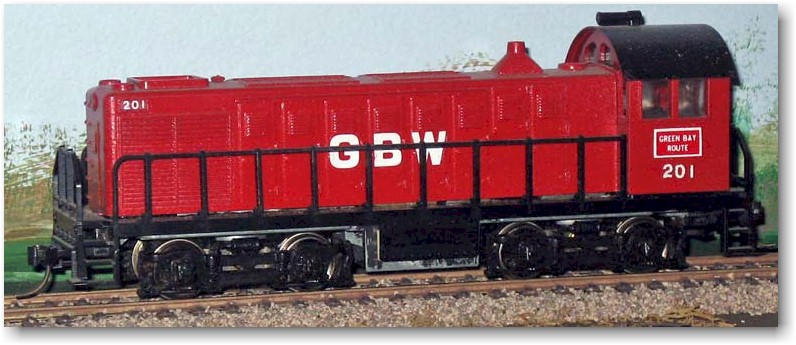
#102 is an Alco S-4. Although similar to the S-2 (above), note that
this locomotive rides on AAR type A switcher trucks instead of the Blunt trucks
under the S-2. This engine shows the all-red paint scheme used on Eddie's
switch engines. Instead of yellow handrails used on many locomotives, these
engines have black handrails.
This model is an AHM body on an Athearn drive.
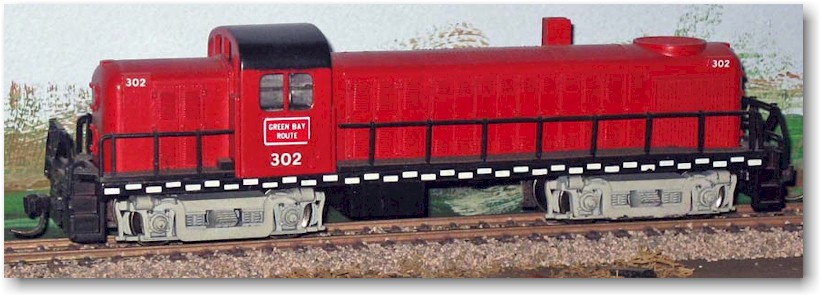
#302 is the sole RS-2 on Eddie's roster. Just like its prototype, this
unit sits on gray trucks -- a carryover from the earlier red-and-gray paint
scheme. Eddie's GB&W simplified the paint scheme on this engine by
eliminating the large "GBW" on the sides of the long hood and only
used the
This model has an AHM body on a scratch built chassis with Athearn motor and trucks.
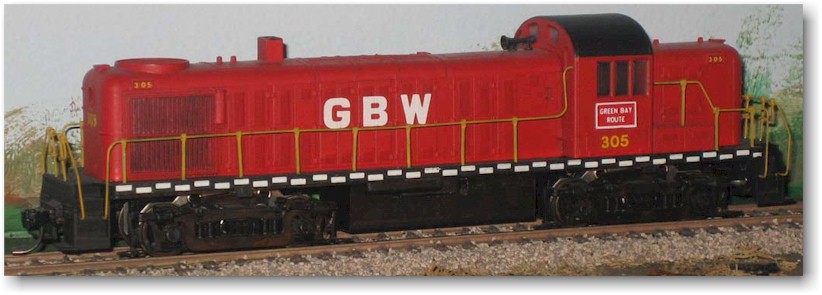
The soot in the radiator grills of this Alco RS-3 identifies it as one of
the harder-working locos on Eddie's layout. #305 may be close to getting
sent to the shops and being rebuilt as an RS-20 like #306 (below). The
paint scheme on this loco is close to the real GB&W in the
1970s. Instead of black handrails like the switch engines and RS-2 above,
the paint shop used yellow on this unit. Also note the white checkerboard
pattern on the side sill. A notable exception to the prototype is the
yellow road numbers on the cab and ands of the hood. I like how the color
of those numbers complement the handrails -- I wish the real GB&W had done
this!
This model is a Roundhouse body and drive.
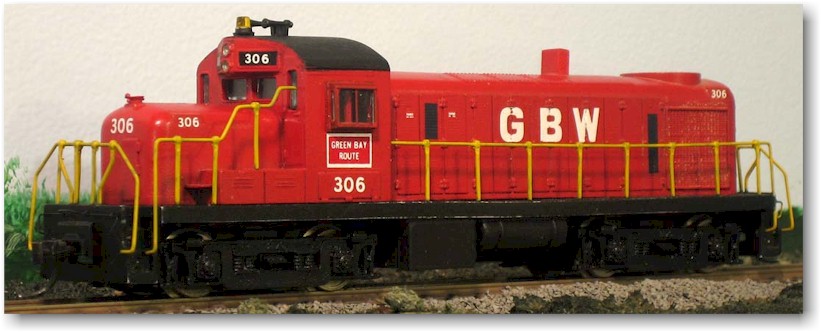
The shop rebuillt RS-3 #306 into a 2000-horsepower "RS-20" with a
low short hood and reconfigured the controls to run short hood forward.
The paint shop used large white road numbers when they repainted it after
shopping it -- compare it to the yellow numbers on #305 above.
This is an AHM RS3 converted to an RS20. Anyone who has attempted an RS-20 conversion can appreciate what Eddie has done to this model. The checkerboard sill stripes are still coming.
.jpg)
This Alco RS-11 GBW #309(1) began life with a high short hood and running
long hood forward. In the 1960s it was rebuilt with a new engine and
chopped short hood and configured to run short hood forward. Here it is
after the GBW began applying the all-red paint scheme of the 1970s.
This AHM model began as a high hood unit factory painted in GBW's red-and-gray scheme of the 1950s & 1960s. This model started Eddie's interest in the GB&W and Alco locomotives. About 20 years ago the motor died in the model, so he converted it into a low nose unpowered unit and repainted it into the all-red scheme. As Eddie recalls, this is probably his first attempt at any kind of model kitbashing and painting.

There is a second #309 on Eddie's roster: This model represents a
"what-if" scenario where the RS-11 was never rebuilt with a low short
hood. The shop crews have apparently reconfigured the engine to run short
hood forward, based on the orientation of the engine on the tracks. The
paint scheme is a transition between that used on #302 and #305
- the yellow handrails, road numbers and the checkerboard side sill reflect the
latter's style, but like the #302 this engine is lacking the large
"GBW" on the sides of the long hood.
This model is an Atlas body. Eddie built the chassis out of brass and used an Athearn motor and trucks.
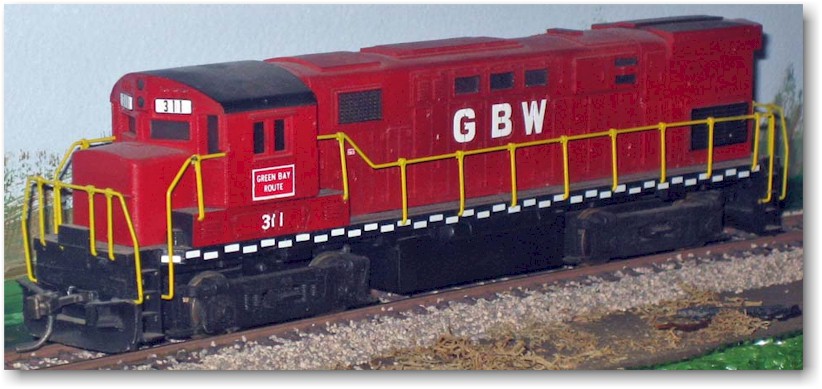
Alco C-424 GBW #311 sits on the ready track on Eddie's layout. This paint
scheme is a faithful reproduction of the prototype in the 1970s. Likewise, most
of the remaining 300- series locomotives on his roster (below) closely follow
the real GBW 1970s paint scheme.
This model is an AHM C424 with a dead motor, which was rebuilt into an unpowered model. The handrails are from an Athearn kit.

One of the most unique units on both the prototype and any modeler's roster is
this Alco C-430 #315. At 3000 horsepower, this was the most powerful
locomotive on the real GB&W, but Eddie's roster has other high-horsepower
units, see below...
This model is a Tyco body. Eddie built the chassis out of brass and used an Athearn motor and trucks. General Electric trucks had closest appearance to the Alco Hi-Ad trucks used on the real locomotive, so he used them on this model,

GBW #319 is still undergoing heavy work by Eddie's GB&W shop forces.
It is an AHM unpowered model. The body is being modified to match the prototype more closely. The trucks are from an Athearn model. This is another one of his longtime projects.
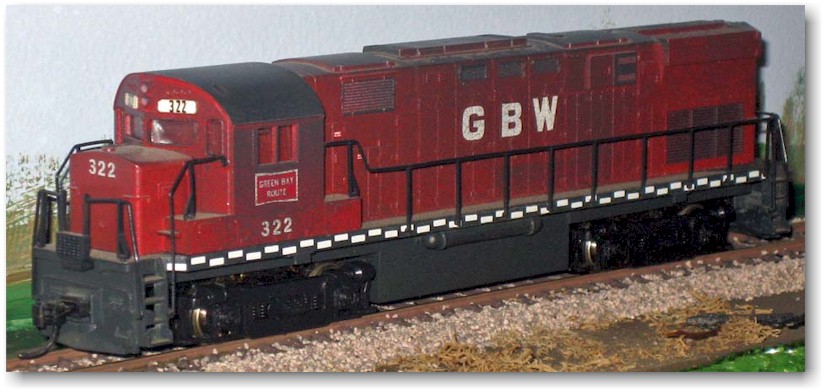
GBW #322 looks very similar to the prototype locomotive late in its time on the
railroad. Eddie visited the Green Bay & Western in 1992 and 1993 and
this was pretty much how they all the prototype power looked at that time.
The body is an Atlas C-424 with a brass scratch built chassis with an Athearn motor and trucks.

Here is the sole Alco C-420 on both Eddie's model GB&W and the prototype
railroad. The smaller 2000-horsepower V-12 engine gave this loco its most
distinct spotting feature: a long low hood, compared the 2400-horsepower C-424s
which needed more room behind the cab to hold a V-16 engine. Here is #323
in the 1970's paint scheme.
The model is a Lima body with an Athearn motor, trucks, and modified chassis.

After Alco quit producing locomotives for the US market in 1969, the GB&W
turned to the Montreal Locomotive Works of Canada for this modern MLW
M440W.
It is a Tyco body with a "Canadian" wide cab and an Athearn chassis and drive.
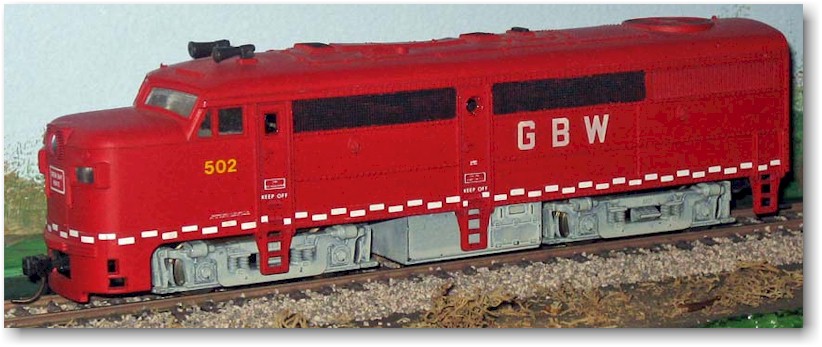
Alco FA-1 came from Alco in the late 1940s, and Eddie's GB&W shops kept the
engines in good working order into the 1970s and painted them in an all-red
scheme. The scheme carries over the gray trucks and yellow cab numbers
from the 1960's red-and-gray scheme. The large "GBW" on the
sides uses a different font than what was used on the hood engines. I like how
the checkerboard pattern is applied to the engine and wraps around the front of
the loco.
This is a Model Power locomotive.
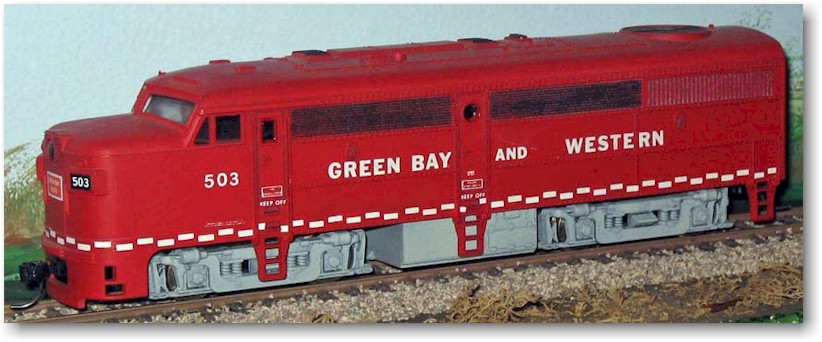
GBW #503 was another survivor into the 1970s which had an experimental all-red
scheme which spelled out the railroad's name on the side of the cab unit.
It never was used on any other equipment - perhaps the railroad felt that the
words weren't legible on the 50+ MPH trains they were running!
This is also a Model Power locomotive.
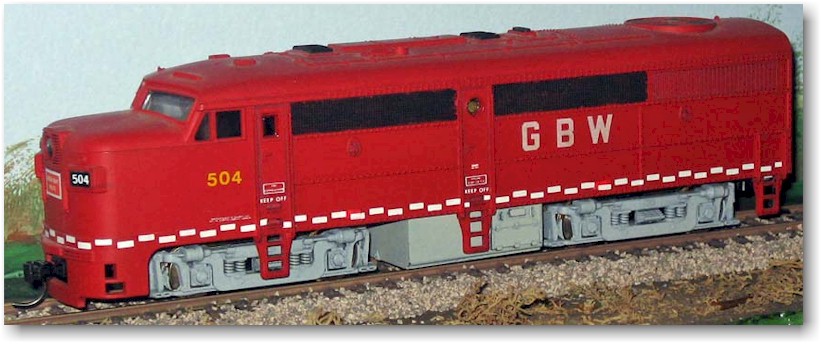
GB&W #504 carries a similar paint scheme to sister unit #502. The air
horn has been removed for repairs from this unit when this photo was taken.
This is also a Model Power locomotive.
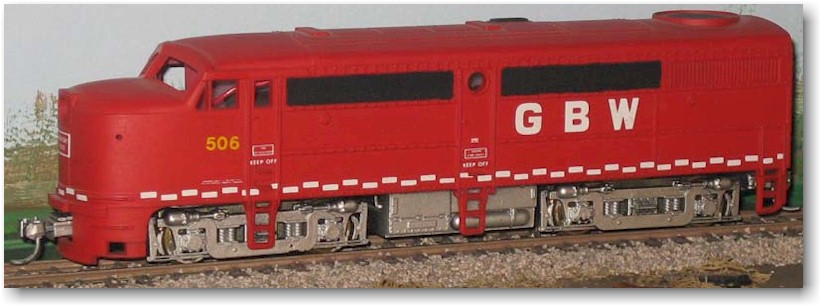
This FA-1 locomotive has an updated "GBW" in a bold font typical of
the prototype locomotives in the 1970s. The silver trucks are similar to
what the real #312 had in the 1980s. Details such as the number
boards and horns are still being worked on.
This is a Train-Miniature model powered by a can motor.

The GBW's original FA-1 was wrecked in a grade crossing
accident several years ago. The railroad picked up a well-worn FB-2 from
the New York Central and now uses it with RS2/RS3s on each end to provide extra
horsepower on their cross-state trains.
This FB-2 Train-Miniature model has an Athearn drive.

The Green Bay & Western went big-time with this six-axle Alco C-628 power on
the fleet! The 601 numbering scheme logically follows the open slot
after the 500- series used by the FA- units. The paint scheme is unlike
anything else on the railroad.
This is an AHM repaint / work in progress.
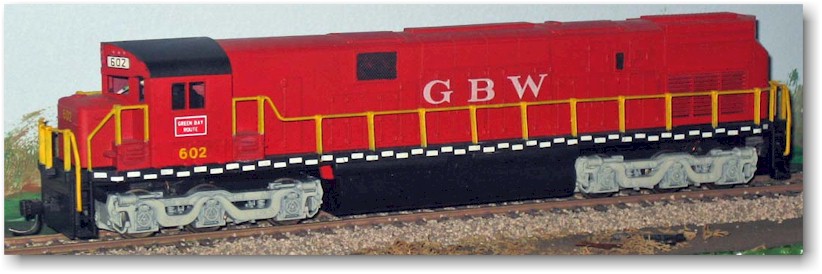
This six-axle engine, has a serif font "GBW" on the long hood.
Its an interesting twist on the standard GBW lettering style... I wonder if more
engines will be wearing it in the future on Eddie's layout? The gray three-axle
trucks under the locomotive provide a great contrast to the black underframe.
This is another AHM Alco C-628 model.

Here's some more big power on the GB&W! The railroad acquired this
high hood Alco C-630 unit with questionable mechanical worth mainly for a parts
supply, so the shops only gave ita basic paint-over of the former Norfolk &
Western paint scheme -- the old lettering still shows through the faded
paint. But the railroad took the time to add the safety checkerboard
stripes to the sill of the locomotive. Note that it rides on
Fairbanks-Morse Trainmaster trucks.
This Alco C-630 is a Tyco body with a modified Athearn chassis & drive.

This was also an ex-Norfolk & Western unit but came via the Chicago
& North Western, which operated a fleet of ex N&W C-628's in ore service
in the Upper Peninsula of Michigan. The paint was still in good shape on
the engine, so the GB&W simply added a herald to the cab sides, similar to
what they did to #902-903 when they were acquired in the
1960s.
This is an AHM body kitbashed to a high nose configuration with an Athearn motor